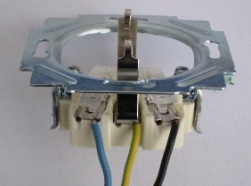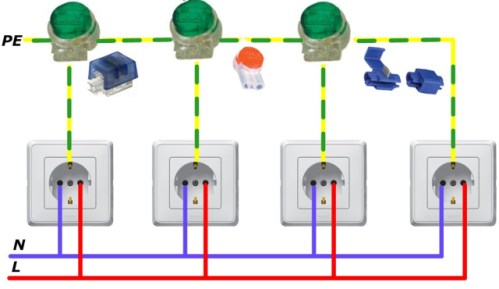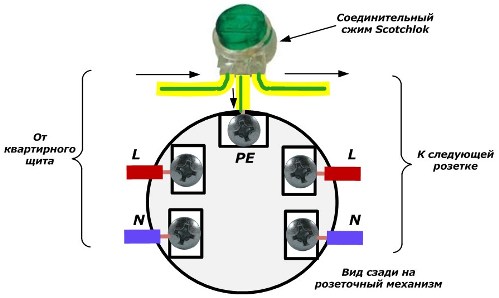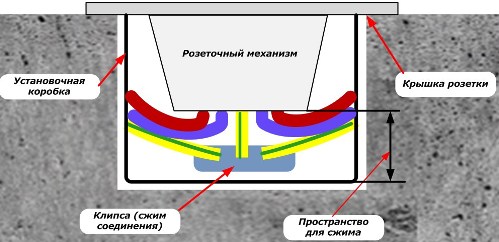Categories: Electrician at home, Sockets and switches, Electric installation work
Number of views: 24815
Comments on the article: 5
How to connect the neutral protective conductor to outlets
 The current rules for the installation of electrical installations impose increased requirements on the reliability of the connection of protective neutral wires and the electrical contacts created by them. In this case, the connection of electrical appliances should be done through a branch, and not a cable.
The current rules for the installation of electrical installations impose increased requirements on the reliability of the connection of protective neutral wires and the electrical contacts created by them. In this case, the connection of electrical appliances should be done through a branch, and not a cable.
To understand the difference between these methods, imagine a fruit tree with a grafted branch. Branches that have grown naturally and extend from the trunk can be considered as one with the tree. The term branching is suitable for them, and the scion is created artificially - this is a train. Under a loop in the energy sector, it is customary to consider a piece of wire connected to an electrical wiring to create a specific electrical circuit.
In other words, the PUE requirement can be explained as follows: the zero conductor protector must be intact throughout its length, which means a ban not only on its creation from separate pieces of wire that are connected in a certain way, but also the connection of additional conductors to it for switching other power consumers.
This requirement is explained simply: when an emergency current appears in a socket or device connected to it, a dangerous potential will flow through the protective conductor, the energy of which can destroy an unreliable connection. In this case, all devices connected to the loop are left without a protective conductor.
Sometimes, electricians make a mistake when wiring, when they tie part of the sockets with one PE conductor without breaking it. To do this, insulation is removed from a small section of the wire, and the metal core is rolled up and clamped under the screw. After that, the free end of the wire goes to the next outlet. This method is not considered a branch and cannot be used.

Connection option PE conductor to outlet
To connect the PE conductor to sockets, it is necessary to use branches to make branches from the protective zero line through the installation box. To connect to it, it is recommended to use special connectorsmanufactured by Wago, Went or Scotchlok. It should be noted that for some electricians the designs of the first two companies are in doubt. Scotchlok clamps for mortise contact have proven their best.
This method involves connecting the sockets to a protective zero by branching, and to the phase and working zero by a loop. It is shown in the figure below. For convenience of perception, gaps of zero and phase are not shown on it.

Wiring diagrams PE conductor to outlet by Scotchlok connector
The connector itself is small, it can be hidden directly in the installation box of the outlet. The wire connection will look something like this.

Connection PE conductor to outlet
To install the connector, it is necessary to provide the amount of free space between the bottom of the installation box and the socket mechanism. It should be equal to or slightly greater than the thickness of the compression with the wires connected.

Installation of a socket with a connection PE conductor connecting device
There is another way to switch the neutral protective conductor to outlets using an additional branch box. It is recommended to install it near plug-in sockets.
A PE conductor from the apartment board is connected to the box and all wires are connected to it branch welding. It is also allowed to use the factory-made terminal blocks in the box.
Such an installation diagram is shown in the figure.

Wiring diagram PE conductor to the outlet via bus
It also does not show gaps created in the phase and working zero conductors.
See also at i.electricianexp.com
:
